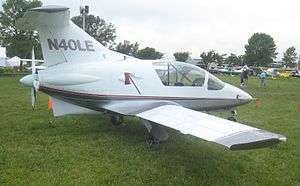Prescott Pusher
The Prescott Pusher is a homebuilt aircraft, with a large cockpit, retractable or fixed gear, T-tail and of pusher configuration, that seats four passengers. Passengers enter the aircraft through a large left-side opening clamshell door.[2]
| Prescott Pusher | |
|---|---|
 | |
| Prescott Pusher | |
| Role | Homebuilt aircraft |
| National origin | United States |
| Manufacturer | Prescott Aeronautical Corporation |
| Designer | Tom Prescott |
| First flight | 9 July 1985[1] |
| Unit cost |
US$20,000 – fixed gear (1986) US$36,500 – retractable gear (1986) |
Design and development
Tom Prescott worked for Sikorsky Aircraft, Piper Aircraft, and Learjet. He left Learjet in 1983 to produce the Prescott Pusher. The pusher was tested using a 1/5 scale model in the Wichita State University wind tunnel in 1983. Flying scale models were tested in 1984, which led to the development of the drooped wing tips for better low speed handling and reduced drag. The aircraft was modeled using CAD/CAM software for creating drawings and defining machine cuts on the fuselage steel, becoming the first CAD/CAM designed homebuilt aircraft. The AVIA Products Co was purchased to develop an electrically controlled variable pitch fiberglass pusher propeller.[3]
The pusher was designed to FAR Part 23 certification standards of the time. It uses aluminum construction for the wings and tail surfaces. The fiberglass landing gear and flaps are hydraulically activated. The nosegear steering is also hydraulic with electric controls. The fuselage uses a 4130 steel welded square steel tube frame with composite skin covering. Every component can be installed prior to skin installation, and in theory, could even be flown without the skins. The wing skins are formed cold using dry ice, then age hardened to T-42 standards. The engine is mounted far aft with a 12-inch propeller extension.[3]
Operational history
The Prescott Pusher was first displayed at the Experimental Aircraft Association airshow in Oshkosh, Wisconsin, in 1985. Prescott Aeronautical Corporation went out of business. In 1991, there were approximately 25–35 builders completing their aircraft in various configurations.[4]
Aircraft on display
Specifications
Data from Sport Aviation[3]
General characteristics
- Crew: One (pilot)
- Capacity: Three passengers
- Length: 20 ft 3 in (6.17 m)
- Wingspan: 28 ft 5 in (8.66 m)
- Height: 8 ft 9 in (2.67 m)
- Wing area: 110 sq ft (10 m2)
- Aspect ratio: 7.3
- Airfoil: NLF(1)-0215
- Empty weight: 1,550 lb (703 kg)
- Gross weight: 2,400 lb (1,089 kg)
- Powerplant: 1 × Lycoming O-360 flat-four engine, 180 hp (130 kW)
Performance
- Cruise speed: 170 kn (190 mph, 310 km/h)
- Stall speed: 50 kn (58 mph, 93 km/h)
- Never exceed speed: 204 kn (235 mph, 378 km/h)
- Range: 870 nmi (1,000 mi, 1,600 km)
- Service ceiling: 18,000 ft (5,500 m)
- Rate of climb: 1,100 ft/min (5.6 m/s)
References
- Thurber, Matt (October 1985). "First Flight of the Prescott Pusher". Reporting Points. Flying. Vol. 112 no. 10. CBS Magazines. p. 106. ISSN 0015-4806. Retrieved 23 August 2016 – via Google Books.
- Campbell, Jim (August 1986). "Hot Wings". Aviation. Popular Mechanics. Vol. 163 no. 8. Hearst Corporation. pp. 76–79. ISSN 0032-4558. Retrieved 23 August 2016 – via Google Books.
- Dick Cavin (March 1986). "Tom Prescott's Pusher". Sport Aviation.
- Jack Cox (September 1991). "Russ and Marcia Taylor's Prescott Pusher". Cite journal requires
|journal=(help) - "Prescott Pusher". Kansas Aviation Museum. Retrieved 23 August 2016.
External links
![]()